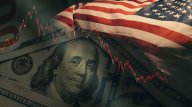Featured articles

Euro forecast: Third-party price target
Read our EUR/USD forex rate forecast for 2025 and beyond, with insights from third-party analysts and market experts
12:06, 4 July 2025

Tesla stock forecast: third-party Tesla (TSLA) price target
Discover the Tesla (TSLA) stock price forecast, with predictions, price drivers, and Tesla CFDs trading strategies on Capital.com
12:42, 10 July 2025

Trading Bitcoin's all-time high in July
Breakout in price finally sees $118,000, keeping technicals bullish in both daily and weekly time frames.
10:16, 11 July 2025
Latest news

Why Michael Burry just sold all his stocks
Michael Burry just sold over $70 million in stock, liquidating his entire portfolio except for one stock, doubling down on a company that other investors are fleeing in droves.
7 hours ago

An unprecedented signal just triggered on the US Dollar
The US dollar just collapsed against the Taiwanese new dollar, with the pairing falling 8% in just a few days, crashing below this key support line and reaching its lowest level in over a year.
14:17, 17 July 2025

Trading Gold’s short-term bull channel
Denial of Fed Chair Powell’s removal has meant a pullback off the highs, but what will it take to get gold prices to break out of its short-term bull channel?
07:23, 17 July 2025

Nasdaq 100: Trading US CPI
Futures up on Nvidia’s China sales resumption of AI chips, but the next test is US pricing data.
06:29, 15 July 2025

Cocoa price prediction: Third-party target
Read our cocoa price forecast for 2025 and beyond, with insights from third-party analysts and commodities market experts.
15:58, 14 July 2025

Top 5 biggest short squeezes
Explore five iconic short squeeze cases like GameStop & Tesla. Learn how positioning, sentiment & timing drive dramatic market moves.
15:09, 14 July 2025

Nvidia stock forecast: Third-party price target
Discover third-party Nvidia stock forecast predictions for 2025-2030 and beyond, with analyst targets, historical prices, and trading strategies.
15:41, 11 July 2025

Trading Bitcoin's all-time high in July
Breakout in price finally sees $118,000, keeping technicals bullish in both daily and weekly time frames.
10:16, 11 July 2025

Tesla stock forecast: third-party Tesla (TSLA) price target
Discover the Tesla (TSLA) stock price forecast, with predictions, price drivers, and Tesla CFDs trading strategies on Capital.com
12:42, 10 July 2025

Ripple XRP price prediction: Third-party price target
Discover the ripple (XRP) price predictions for 2025 and beyond, with analyst price targets and CFDs trading strategies on Capital.com
16:25, 8 July 2025
